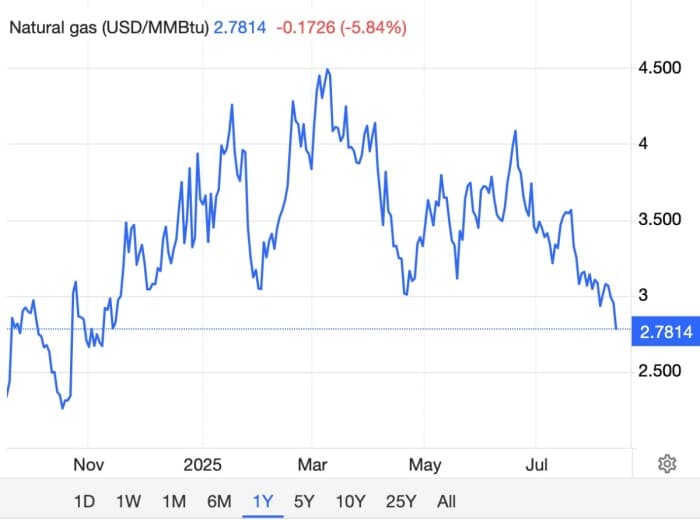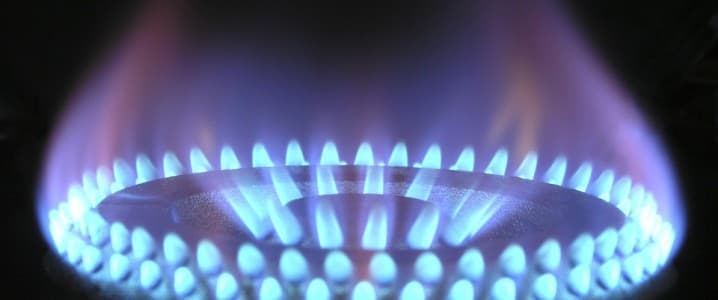No commodity likes a hot summer like natural gas, when used to air-condition homes and businesses.
Unfortunately for natural gas bulls, despite a hot next few days, milder weather forecasts for the second half of August, combined with robust storage levels and output, pushed US natural gas futures below $2.90 per MMBtu, Tuesday, their lowest level since November 2024.

US natural gas futures. Source: Trading Economics
According to Trading Economics, output in the Lower 48 states averaged 108.3 billion cubic feet per day (bcfd) so far in August, compared to July’s record 107.9 bcfd.
[Inventories are] about 7 percent above seasonal norms and expected to keep growing. Meteorologists still see above-normal heat through August 27 but with lower intensity than previously forecast, reducing demand.
Also on Aug. 12, the Wall Street Journal reported US natural gas futures fell for a fourth straight session, with buoyant production and forecasts for a cooler second half of August keeping up concerns about surplus inventories.
The Energy Information Administration (EIA) lowered its Henry Hub price estimate for the rest of the year by 3%, expecting gas in underground storage to end the injection season (April to October) 2 percent above the five-year average, instead of the 3 percent below average forecasted in April.
“Our higher end-of-season storage forecast is largely the result of more natural gas production and fewer liquefied natural gas exports than we had expected in April,” the EIA said.
However, the EIA also stated it expects natural gas inventories to fall closer to the five-year average in the coming months, putting upward pressure on prices.
In its Short-Term Energy Outlook dated Aug. 12, the energy agency said it expects the Henry Hub price to average around $3.60/MMBtu in the second half of 2025 and $4.30 in 2026 — 21 percent and 6 percent lower, respectively, than forecasted in April.
Next April should see a monthly bottom for 2026 prices at around $3.60/MMBtu, rising from there and reaching $5.40/MMbtu in December.
Higher LNG exports should brighten the price picture. The EIA expects LNG exports to grow around 2 bcfd, “further tightening supply-demand balances and contributing to higher prices later in the forecast period.”
Rising natural gas production in recent months has added to higher-than-anticipated inventory levels. The EIA expects marketed production to grow by 2 percent over 2024 volumes, supported by growth in the Permian, Haynesville and Appalachia regions. Drill rigs are being deployed to gas-intensive shale plays. Baker Hughes reported on Aug. 8 that 19 more rigs were drilling for natural gas than at the start of April, an 18 percent increase.
The EIA expects falling oil prices will reduce production of associated natural gas, particularly in the Permian Basin. “However, production declines will be muted as producers strategically position themselves to meet rising demand from several LNG projects that are set to enter service in late 2025 and 2026.”
BOE Report had a slightly different take on the EIA’s Short-Term Energy Outlook. It said that US natural gas output and demand will both rise to record highs in 2025 before sliding in 2026. The agency also forecasts average US LNG exports to reach 14.7 bcfd in 2025 and 16.3 bcfd in 2026, up from a record 11.9 bcfd in 2024.
Answering the question, ‘Have Natural Gas Prices Bottomed?’, Jim Roemer, publisher of Weather Wealth newsletter, on Aug. 8 said about two weeks ago he (correctly) predicted prices would fall below $3 due to cooler US weather and fewer LNG exports to Europe. Colder European weather was also part of the picture.
Roemer notes weather models are a bit warmer for both Europe and the US as we head deeper into August, which may be enough to staunch the bleeding among natgas investors.
Some models are forecasting a Gulf hurricane in mid- to late-August, which could disrupt supplies and shore up weak prices.
Roemer notes natural gas prices tend to bottom by August if there is normal to hot US weather.
The United States is the top producer of natural gas, followed by Russia.
By Andrew Topf for Oilprice.com
More Top Reads From Oilprice.com
